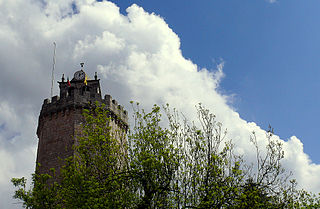
The district of Guarda is located in the Centro Region of Portugal, except Vila Nova de Foz Côa, which is in the Norte Region. The district capital and most populous city is Guarda. It borders Spain.

The Castle of Belver is a Portuguese castle in the civil parish of Belver, municipality of Gavião, district of Portalegre, in central Portugal.

The Castle/Fortress of Almeida is a castle situated in the civil parish of Almeida, in the municipality of Almeida in the Portuguese district of Guarda, in the former-northwestern province of Beira Alta. It was constructed in this region due to its significant strategic importance, due to its close proximity to the border between Portugal and Spain. It is classified as a National Monument. The 1810 explosion: the magazine which was the seat of the explosion was in the cathedral adjacent to the castle, not the castle itself as reported in the text.

The Castle of Castelo Branco is a Portuguese medieval castle in civil parish of Castelo Branco, in the municipality of the same name, in the Centro district of Castelo Branco. Known locally as the Castelo dos Templários, the Romanesque castle was constructed under the orders of King Afonso II of Portugal in 1214.

The Castle of Monsanto is a medieval castle located in the civil parish of Monsanto e Idanha-a-Velha, in the municipality of Idanha-a-Nova, Portuguese district of Castelo Branco.

The Castle of Moreira de Rei is a well-preserved medieval castle located in the civil parish of Moreira de Rei, in the municipality of Trancoso, Portuguese district of Guarda.

The Castle of Alcanede, is a Portuguese medieval castle in civil parish of Alcanede, in the municipality of Santarém, in the Ribatejo district of Santarém.

The Castle of Avô is a medieval castle located in the civil parish of Avô, municipality of Oliveira do Hospital, in the Portuguese district of Coimbra.

The Castle of Folgosinho, is a medieval castle in the civil parish of Folgosinho, municipality of the Gouveia in the district of Guarda in the Centre region of Portugal.

The Castle of Vilar Maior is a well-preserved medieval castle located in the civil parish of Aldeia da Ribeira, Vilar Maior e Badamalos, in the municipality of Sabugal, Guarda district, Portugal.
The Castle of Alva is a medieval castle located in the civil parish of Viade de Baixo e Fervidelas, in the municipality of Freixo de Espada à Cinta, Portuguese district of Bragança.

The Castle of Freixo de Espada à Cinta is located in the civil parish of Freixo de Espada à Cinta e Mazouco, municipality of Freixo de Espada à Cinta, in the Portuguese district of Bragança.

The Castle of Penedono is a medieval castle located in the civil parish of Penedono e Granja, in the municipality of Penedono, Portuguese district of Viseu.

The Castle of Óbidos is a well-preserved medieval castle located in the civil parish of Santa Maria, São Pedro e Sobral da Lagoa, in the portuguese municipality of Óbidos. Historical province of portuguese Estremadura.

The Castle of Santo Estêvão is a medieval castle located in the civil parish of Santo Estêvão, municipality of Chaves, in the Portuguese district of Vila Real. Located in a dominant position over the village, the castle is within walking distance of the course of the river Tamega and the border with Spain.

The Castle of Castelo Melhor is a medieval castle located in the civil parish of Castelo Melhor, in the municipality of Vila Nova de Foz Côa, Portuguese Guarda. The castle is one of the best examples of secondary medieval fortresses, erected in one of the more peripheral zones of the peninsular kingdoms.

The Castle of Castelo Bom is a medieval castle in the civil parish of Castelo Bom, municipality of the Almeida in the district of Guarda in the Centre region of Portugal.

The Castle of Ródão is a medieval castle located in the civil parish of Vila Velha de Ródão, in the municipality of Vila Velha de Ródão, Portuguese Castelo Branco.

The Former Cathedral of Idanha-a-Velha is the decommissioned medieval Catholic cathedral of the former bishopric of Egitânia, in the Freguesia of Monsanto e Idanha-a-Velha, in the municipality of Idanha-a-Nova, in the central Portuguese district of Castelo Branco.

The Castle of Penamacor is a medieval castle located in the civil parish of Penamacor, in the municipality of Penamacor, Portuguese district of Castelo Branco.


























